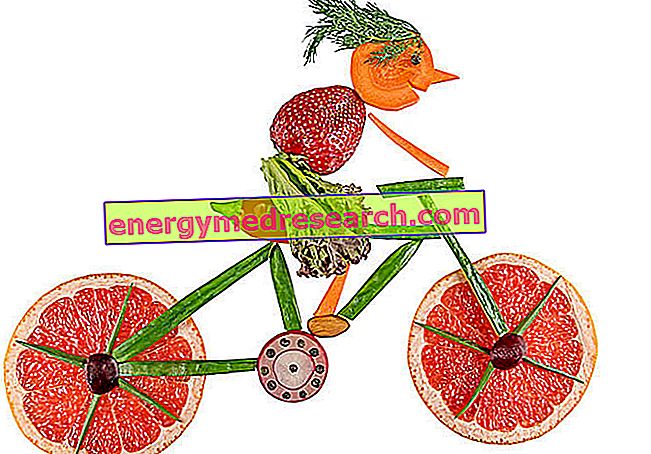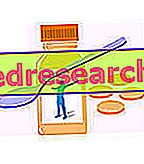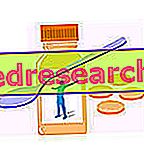Food and weight loss
Weight loss is a process of reduction of the adipose mass that causes, consequently, a decrease in body weight.
The necessary conditions for weight loss are three:
- Energy consumption higher than food calorie intake
- Dietary balance, understood as the correct distribution of nutrients and meals, and suitability of the portions (to which the load and the glycemic index, the percentage of fat, etc. are correlated)
- State of normal health and physiological homeostasis (hormonal balance and absence of pathologies that can compromise the disposal of the adipose content such as, for example, the insulin resistance not compensated).
Therefore, there are no foods capable of "losing weight". It is a multi-factorial dietary property, influenced above all by the portion, the meal and the general dietary composition.

Features
Characteristics of the foods that make you lose weight
What are the characteristics of the foods that make you lose weight?
In the organization of a slimming nutritional scheme, certain foods can be considered more or less adequate. It may seem strange but, besides the chemical composition, the criterion that most influences this aspect is the satiating capacity, which inexorably has repercussions on the practicability of the portion.
Finally, as a result of the relationship between the chemical composition and the portion, the metabolic impact is obtained.
In short, the food that lends itself most to weight loss must have the following characteristics:
- Low caloric density
- Low amount of lipids (except for seasoning fats, such as oil)
- Low or medium amount of carbohydrates
- Absence of ethyl alcohol
- High amount of water
- High amount of fiber.
There are also some foods and beverages to which, sometimes quite unjustifiably, slimming capacities are attributed. Later we will see what they are.
Chemical composition
Chemical composition of foods that make you lose weight
In the slimming context, the chemical composition of foods is a fundamental aspect. Above all it is important to evaluate the distribution of energy macronutrients: available carbohydrates, fatty acids and proteins.
Based on the fundamentals of the Mediterranean diet, carbohydrates must be the most abundant, with less importance than simple sugars (especially added ones) to the benefit of complex polymers (starch). Follow the lipids (25-30% of total calories) and finally the proteins (the recommended quantity is the subject of controversy, but also for the more permissive bibliographic sources it must not be higher than 18-20%).
Since each energy nutrient supplies a different caloric quantity (fatty acids 9 kcal / g, proteins 4 kcal / g glucides 3.75 kcal / g), the prevalence of one or the other in relation to the quantity of water and fibers (which does not provide calories), establish the caloric density of the food.
We could therefore say that the foods that make you lose weight are low in calories, thanks to the low concentration of energy nutrients (especially lipids) and to the richness of water and fibers.
Satisfying capacity
Foods that make you lose weight have a high satiating capacity. This parameter measures the amount of food needed to inhibit appetite stimulation. The so-called satiety is the result of different stimuli launched by the digestive system, among which the most relevant are:
- Visceral fullness, which releases hormones and neurotransmitters following the distension of the stomach
- Increase in insulinemia. Insulin is a hormone that is stimulated by the increase of certain nutrients in the blood (glucose, amino acids and fatty acids. It performs many metabolic functions - anabolic and, at the same time (in the physiological field), reduces the desire to eat.
Water and fiber are the nutritional factors that make it easier to achieve visceral fullness without exceeding energy nutrients and calories. Moderate amounts of easily digested carbohydrates quickly, but not excessively, stimulate insulin.
On the contrary, proteins and fats have a slower digestion and generally require a longer time, which is why they feed less in the short term; it would therefore be useful to wait for the time necessary to advance digestion and absorption. High amounts of each nutrient significantly increase insulin levels but provide a lot of calories.
Portion
Practicability of the portion of food
It is an often overlooked detail. In truth, the practicability of the portion is the basis of the success of a food therapy.
Each food therefore has a medium recommended portion and a so-called practicable portion. That advisable corresponds to the quantity of food that, based on the nutritional content and the satiating capacity, the LARN (Nutrient Reference Energy Levels and energy) suggest to adopt.
That practicable, in most cases similar to the previous one, refers to subjectivity but also to reasonableness (without straying too far from the average).
In a controlled diet, a certain food / recipe / meal aims to provide calories and nutrients in precise quantities. Between two foods with different energy intake, the most energetic portion of the food is lower than the other; in fact, in slimming diets often "not exactly low-calorie" foods are given in smaller quantities.
On the other hand, one must always deal with the satiating capacity. For the same number of calories, a very fatty food could require portions of ½ or even 1/3 compared to another skinny one. As a result, we will have the same amount of energy but, while in the first case the portion is almost certainly NOT practicable, in the second it is perfectly adequate (for example 30 g of pancetta VS 100 g of chicken breast).
Metabolic Impact
Metabolic impact means the body's reaction after nutritional intake. It covers individual energy nutrients, foods, recipes and whole meals. For weight loss purposes, it is necessary that:
- Moderate amounts of glucose and triglycerides are present in the bloodstream
- Metabolism is more prone to catabolism than adipose anabolism.
To moderate triglyceridemia it is necessary that meals are free of ethyl alcohol, contain moderate amounts of lipids and do not have an excessive glycemic load.
Furthermore, since the fat is deposited mainly by insulin which, as we have said, increases in relation to the entry of nutrients into the circulation, the main objective is to stimulate it with moderation.
Let me be clear, insulin is an essential chemical messenger and very useful (especially for muscle recovery in athletes), but if in excess it predisposes to fat deposits and prevents weight loss.
Weight-loss foods do NOT provide too many nutrients, especially alcohol, fatty acids and carbohydrates; the excess of the latter two, in addition to increasing triglyceridemia (as well as a part of the excess amino acids, are converted into fats by the liver), greatly stimulate insulin, which causes the body to gain weight instead of losing weight.
Slimming Foods
What are the foods that make you lose weight?
Clarify the fundamental characteristics of the foods that make you lose weight, below we will give some practical examples.
To create a logical order, we will take advantage of the traditional subdivision of the 7 fundamental food groups.
Before starting, it is advisable to clarify a very important aspect: the characteristics of foods must always be evaluated in their ready-to-eat form, ie the one that is “in the dish”. It may seem trivial but it is not. For example, if we evaluate the chemical composition, satiating capacity, portion and metabolic impact of polenta flour, we would come to the conclusion that it is a high calorie food, not very satiating because it is waterless, with a high glycemic load and therefore potentially with a high insulin index . It is not so. During cooking the polenta flour absorbs water for 400% of its initial weight, with a consequent reduction to 1/4 of the calories and quadrupling of the satiating capacity.
In the same way, a fillet of plaice well cooked in a pan with a drizzle of oil halves its water content and increases its content in lipids, with a consequent doubling of the energy and halving of the satiating capacity.
So be careful to objectively evaluate the foods that will make up your weight loss diet.
Group 1: meat, fish and eggs
Lean products are preferred: some examples are chicken, turkey, rabbit, lean cuts of beef or pork, hare, pheasant, cod, anchovies, plaice, pike, octopus, cuttlefish, mussels, clams, snails, whole eggs (no more of 3 per week), egg whites etc.
Among the best recipes based on meat, fish and eggs stand out: carpaccio and tartare, stewed in sauce with little or no oil (eg hare stew) and quick cooking on pan or non-stick plate, or grill, without oil.
Group 2: milk and derivatives
Even in this case, those with little fat are more suitable: low-fat milk, low-fat yogurt, low-fat ricotta, light milk flakes, light mozzarella, light spreadable cheese.
Group 3 and 4: Cereals and Derivatives, Tubers - Legumes
Cereals or wholemeal derivatives are to be preferred: whole wheat, brown rice, whole barley, whole spelled etc. The same applies to their flours and foods that contain them, such as whole-grain pasta and bread.
They are not cereals but pseudo-cereals such as quinoa, amaranth, buckwheat, chia etc. must be treated in a similar manner.
Potatoes, especially large ones as soon as they are picked, must necessarily be peeled. Many people do not consider them suitable foods for weight loss but in reality they contain half the calories of cooked pasta.
Legumes are less caloric, absorb more water and contain more fiber than whole grains, therefore they lend themselves very well to low-calorie nutritional regimes. The most suitable recipes are: polenta and semolina (also with flour different from wheat), risotto (also with other cereals) without oil and butter, soups with legumes or other starchy seeds.
Group 5: Fats and Seasoning Oils
Extra virgin olive oil and many others of cold-pressed vegetable origin are excellent sources of vitamin E and unsaturated fatty acids (monounsaturated and polyunsaturated, even essential). However, they are not foods that make you lose weight. Some find the so-called spray oil without calories (alimentary vaseline) useful, but in this way increases the risk of imbalance in the ratio between the fatty acids of the diet and the lack of fat-soluble vitamins.
Group 6 and 7: Vegetables and Fruits Sources of Vit A and Vit C
Vegetables and fruits are rich in water and fiber. They help both reach gastric fullness and soluble fibers, forming a gel in the intestine, reducing the rate of absorption of carbohydrates, insulin growth, fat absorption and therefore total calories.
Almost all are good, with the exceptions of fatty fruits such as avocado and coconut, or fruits (mostly autumnal) very rich in carbohydrates (simple or complex), often with a high glycemic index: chestnuts, ripe banana, grapes and mandarin . Figs, pomegranates and persimmons should also be eaten with moderation.
It is important to specify that fruits and vegetables contain above all fructose, which has the same calories as glucose, but stimulates less insulin. In the context of a balanced diet, this is certainly a metabolic advantage; instead it becomes a problem for those who choose to use them to replace bread and pasta. In fact, as we have already said, insulin is essential for the onset of satiety; eating only fruit and vegetables can happen to reach the fullness of the stomach while still having "the desire to eat".
Fat burning
Are there any fat burning foods?
No. There are no foods that allow you to burn fat better. Some products, despite their reputation, are completely ineffective, such as:
- Grapefruit
- Lemon
- Pineapple
- Chili pepper etc.
Others contain particular active ingredients, sometimes effective on guinea pigs but scarce for humans, as in the case of the bitter orange synephrine.
A third category contains molecules that, even if they intervene in the lipid metabolism, do so in an irrelevant or insufficient way for the purpose. For example: coffee, raw green coffee, tea, ginseng, guarana and other products containing nervine molecules that (in favorable metabolic conditions) facilitate the mobilization of fatty acids but not their cellular oxidation.
Diet
Example of fingers with foods that make you lose weight
To facilitate understanding of what we have explained so far, we will illustrate below a menu containing the foods that make you lose weight comparing it to another that, despite having the SAME PORTIONS, does not show the recommended characteristics.
| Overweight subject, with a NORMAL calorie requirement of 2100 kcal | |||
| MENUS WITH FEEDING FOODS | INCORRECT MENU | ||
| Breakfast | Breakfast | ||
| Skimmed cow's milk | 200 ml | Whole milk | 200 ml |
| Oatmeal | 35 g | Rusks + hazelnut spread | 16 g + 20g |
| Snack | Snack | ||
| Apple, with peel | 200 g | Crackers | 25 g |
| Lunch | Lunch | ||
| Instant polenta (ready) with mushrooms | 300 g +100 g | Slice of pizza with 4 cheeses | 150 g |
| Grilled chicken steak | 100 g | Frankfurters | 100 g |
| Lettuce | 70 g | Cauliflower graten | 100 g |
| Whole grain bread | 25 g | breadsticks | 25 g |
| Extravirgin olive oil | 10 g | TOT extra virgin olive oil | - |
| Snack | Snack | ||
| Light yogurt | 125 g | Flavored creamy yogurt | 125 g |
| Dinner | Dinner | ||
| Steamed octopus | 150 g | Fried squid | 150 g |
| Cherry tomato salad | 200 g | French fries | 150 g |
| Whole grain bread | 75 g | taralli | 30 g |
| TOT extra virgin olive oil | 10 g | TOT extra virgin olive oil | - |
| Snack | Snack | ||
| Orange | 200 g | Grapes | 200 g |
| TOT calories | 1450 kcal | TOT calories | 2700 kcal |
| Energy from fat | 26% | Energy from fat | 52% |
As you can see, the diet menu containing the foods that make you lose weight brings 650 kcal less than the normocaloric diet (2100Kcal), promoting a weight loss of about 3 kg per month, and 1250 kcal less than the unsuitable one, which with its 600 kcal too would certainly fatten the subject.
It is important to note that the total mass of food in the first menu is even higher than that of the second, which ensures a greater satiating capacity. Moreover, even if it is not evident in the table, the first solution meets the needs of water, fibers, mineral salts and vitamins; moreover, it has an excellent ratio between fatty acids, contains little cholesterol and sodium, while it is rich in polyphenolic antioxidants.



